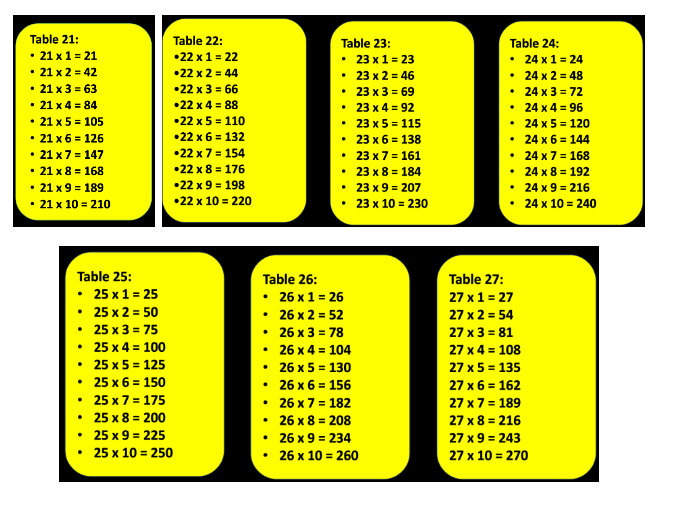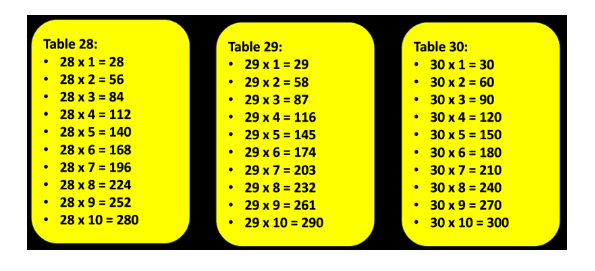Table of Contents
Introduction
Multiplication tables, also known as times tables, are fundamental tool in mathematics that provide a systematic way of representing and understanding multiplication operations. These tables are structured grids that display the results of multiplying two numbers within a specific range.
The primary purpose of multiplication tables is to help individuals learn and memorize multiplication facts, making it easier and quicker to perform multiplication calculations. These tables serve as a valuable reference for students, educators, and anyone working with numbers.
The structure of multiplication tables follows a consistent pattern. Learning multiplication tables is essential for developing strong mathematical skills. Mastery of these tables not only enables individuals to perform multiplication calculations accurately and efficiently but also serves as a foundation for more advanced mathematical concepts, such as division, fractions, algebra, and problem-solving.
Multiplication tables are widely used in educational settings to teach multiplication facts and reinforce computational fluency. They are also utilized in everyday life, such as calculating prices, determining quantities, measuring dimensions, and solving various real-world problems.
Importance of Table 21-30
Multiplication Skills: Tables 21-30 help individuals develop and improve their multiplication skills. By memorizing or referring to these tables, one can quickly perform calculations involving numbers from 21 to 30 and their multiples.
- Mathematical Operations: Multiplication is a fundamental mathematical operation used in a wide range of mathematical problems, such as solving equations, finding areas and volumes, calculating rates, and determining proportions. Tables 21-30 provide a reference for performing these calculations efficiently.
- Problem Solving: Tables 21-30 are useful in problem-solving situations that involve quantities related to numbers within this range. They assist in finding solutions and making accurate calculations in various fields, including mathematics, physics, engineering, and finance.
- Academic Success: Proficiency in multiplication, including tables 21-30, is essential for academic success, particularly in mathematics-related subjects. These tables serve as a foundation for more advanced mathematical concepts and calculations encountered in higher-level education.
- Efficiency and Time-Saving: Memorizing or having quick access to multiplication tables 21-30 can significantly enhance computational efficiency and save time in day-to-day tasks that involve calculations. This can be particularly beneficial for students, professionals, and individuals working in fields where rapid and accurate calculations are required.
- Practical Applications: The tables from 21 to 30 are relevant in various real-life situations. They can be used in tasks such as measuring quantities, determining costs, calculating time and distance, understanding patterns, and analyzing data sets.
- Building Confidence: Mastering multiplication tables 21-30 can boost one’s confidence in handling numerical operations. Being able to perform calculations quickly and accurately contributes to a sense of competence and ease with mathematical concepts.
Multiplication Tables 21 to 30

Also Read
Conclusion
In conclusion, multiplication tables are a valuable tool for learning and mastering multiplication facts. They provide a structured representation of multiplication operations, allowing for efficient calculations and facilitating mathematical understanding. Whether in classrooms, professional settings, or everyday life, multiplication tables are indispensable for developing numeracy skills and solving mathematical problems.
Related Links:
FAQs on Tables 21 to 30
How to learn table 21 to 30?
Learning multiplication tables from 21 to 30 can be made easier by following these strategies: Practice Regularly: Dedicate consistent practice time to memorize and review the tables. Repetition helps in reinforcing the multiplication facts and improving recall. Break it Down: Instead of trying to learn all the tables at once, focus on one table at a time. Start with table 21 and master it before moving on to the next one. Breaking it down into smaller, manageable chunks makes learning more achievable. Visualize Patterns: Look for patterns and relationships within the tables. For example, notice that the units digit of the products repeats in a cyclical pattern, and the tens digit increases by 1 for each subsequent multiplication. Use Mnemonics or Memory Techniques: Create mnemonics or memory aids to associate the multiplication facts with memorable images, phrases, or stories. These can help in retaining the information more effectively. Practice with Flashcards or Online Tools: Utilize flashcards or online multiplication tools that present random multiplication questions for practice. Regular exposure to different combinations helps in reinforcing the tables. Use Real-Life Examples: Relate the multiplication facts to real-life situations or objects. For instance, if you encounter a scenario involving 29 groups of 4 items, visualize it as 29 x 4 and calculate the result mentally. Test Yourself: Regularly test your knowledge by solving multiplication problems without referring to the tables. This helps in assessing your progress and identifying areas that need further practice.
How to learn tables upto 30 easily?
Learning tables up to 30 in five minutes may be challenging, as it requires quick recall and familiarity with a large number of facts. However, you can start by focusing on smaller subsets of tables, such as 1 to 5 or 1 to 10, and gradually expand your knowledge as you become more comfortable.
How to learn tables in 5 minutes?
Learning tables in just 5 minutes can be challenging, as it requires quick recall and familiarity with a large number of multiplication facts. However, you can make the most of this short time by focusing on a specific subset of tables, such as 1 to 5 or 1 to 10. Prioritize the tables that you find most difficult and practice them repeatedly. Use mnemonic techniques, visualizations, and patterns to aid memorization. Practice with flashcards, online tools, or timed quizzes to improve speed and accuracy. Regular and consistent practice over time will help you build a strong foundation in multiplication tables. Remember, while 5 minutes may not be enough to master all tables, it is a starting point towards improving your multiplication skills.
How to read tables?
To read tables, identify the numbers along the top row and leftmost column as the factors to be multiplied. Locate the intersection of the respective row and column to find the product or result of the multiplication.
How can I learn table of 29?
To learn the table of 29 specifically, follow the strategies mentioned earlier. Practice multiplication problems involving 29, use visualizations, and employ mnemonic devices to aid memorization.
What is the square root of 21-30?
The square roots of numbers 21 to 30 are: Square root of 21 ≈ 4.5826 Square root of 22 ≈ 4.6904 Square root of 23 ≈ 4.7958 Square root of 24 ≈ 4.8989 Square root of 25 = 5 Square root of 26 ≈ 5.099 Square root of 27 ≈ 5.1962 Square root of 28 ≈ 5.2915 Square root of 29 ≈ 5.3852 Square root of 30 ≈ 5.4772
What is the cubes of 21-30?
Cube of 21 = 21 x 21 x 21 = 9,261 Cube of 22 = 22 x 22 x 22 = 10,648 Cube of 23 = 23 x 23 x 23 = 12,167 Cube of 24 = 24 x 24 x 24 = 13,824 Cube of 25 = 25 x 25 x 25 = 15,625 Cube of 26 = 26 x 26 x 26 = 17,576 Cube of 27 = 27 x 27 x 27 = 19,683 Cube of 28 = 28 x 28 x 28 = 21,952 Cube of 29 = 29 x 29 x 29 = 24,389 Cube of 30 = 30 x 30 x 30= 27,000
In which table 243 will come?
The number 243 will come in the table of 9. In the multiplication table of 9, you will find that 9 multiplied by 27 equals 243.








